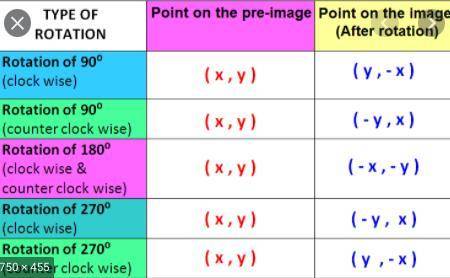
Mathematics, 06.07.2020 06:01 jiggyN
Triangle ABC was transformed using the rule (x, y) → (–y, x). The vertices of the triangles are shown. A (–1, 1) B (1, 1) C (1, 4) A' (–1, –1) B' (–1, 1) C' (–4, 1) Which best describes the transformation? The transformation was a 90° rotation about the origin. The transformation was a 180° rotation about the origin. The transformation was a 270° rotation about the origin. The transformation was a 360° rotation about the origin.

Answers: 2
Another question on Mathematics

Mathematics, 21.06.2019 12:30
If an x intercept only touches the x axis it means it has a multiplicity of 2. if an intercept goes through the axis it has a multiplicity of 1 true false
Answers: 1

Mathematics, 21.06.2019 23:00
If you apply the changes below to the linear parent function f(x)=x what is the equation of the new function vertically stretched by a factor of 3 flip over the x axis
Answers: 2

Mathematics, 22.06.2019 00:30
Find the area of just the wood portion of the frame. this is called a composite figure. you will need to use your values from problem #2need all exepct 4 answerd if you can
Answers: 1

Mathematics, 22.06.2019 01:30
The pyraminx is a rubik's cube-type toy in the shape of a tetrahedron. the pyraminx shown below has edges 15\,\text{cm}15cm long and vertical height h=12.2\,\text{cm}h=12.2cm. the triangle drawn with dashed lines is a right triangle. what is the distance rr? round your answer to the nearest tenth.
Answers: 1
You know the right answer?
Triangle ABC was transformed using the rule (x, y) → (–y, x). The vertices of the triangles are show...
Questions






Mathematics, 12.05.2021 17:20

Biology, 12.05.2021 17:20



Mathematics, 12.05.2021 17:20


Mathematics, 12.05.2021 17:20


English, 12.05.2021 17:20

English, 12.05.2021 17:20


English, 12.05.2021 17:20


Health, 12.05.2021 17:20




